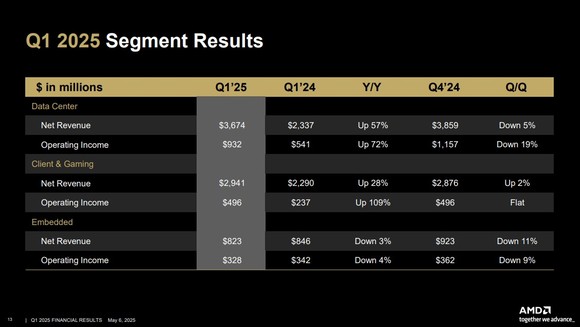Over the last two years, semiconductor powerhouse Nvidia (NVDA +1.68%) has emerged as the biggest force fueling the artificial intelligence (AI) revolution. The company's industry-leading graphics processing units (GPU) and CUDA software platform have helped Nvidia build a substantial lead over its competition in the chip market.
While Advanced Micro Devices has carved out an impressive pocket for itself in the AI data center landscape, recent reporting suggests that the company is still far behind Nvidia.
Let's explore the dynamics behind Nvidia's lead over AMD, and assess if the king of the chip realm just made its checkmate move against its top rival.

NASDAQ: NVDA
Key Data Points
Nvidia continues to dominate the competition
During the early phases of the AI megatrend, Nvidia benefited from having a first-mover advantage over other semiconductor companies when it comes to GPUs specifically. While being a first mover can help companies experience outsized growth relative to the competition or form strategic partnerships with leaders in adjacent industries, there's no guarantee that these businesses can sustain their leads.
In the case of Nvidia, however, trends suggest that company's lead over AMD may only be getting bigger.
Beth Kindig, who serves as a technology research analyst and CEO of I/O Fund, recently shared a data point from SemiAnalysis that pointed out that Nvidia's market share in AI accelerators increased by roughly two points during the first quarter -- now hovering around 88%. By contrast, AMD's share shrunk by about one point, now comprising roughly 4% of the market.

Image source: Getty Images.
Why these trends could spell trouble for AMD
The chart illustrates AMD's revenue and operating income by reportable segment during the first quarter. One of the more notable takeaways is that AMD's data center operation is its fastest-growing business, all while remaining highly profitable.

Data source: AMD investor relations.
However, a more subtle idea is that sales from the data center business shrunk by 5% quarter over quarter. To be fair, there could be a number of reasons for this.
First, the semiconductor industry is cyclical -- which makes quarterly trends tougher to predict and gauge when it comes to the overall health of the business. In addition, AMD's latest accelerator architectures are expected to ship later this year. This timeline could be playing a role in the slight deceleration of the data center business compared to the fourth quarter.
While these ideas may make some sense in theory, I find them hard to believe, given Nvidia actually gained ground in the AI accelerator market during the first quarter.
Since AI developers raced to buy Nvidia's newest Blackwell chips, factors such as cyclicality or new competitive chipsets from AMD didn't seem to be enough to persuade customers from waiting on AMD's products over those of Nvidia.
In the long run, these dynamics could spell trouble for AMD. Despite the company's ability to win impressive data center customers such as Oracle, Meta Platforms, and Microsoft, AMD's innovative efforts do not appear to be enough to outmaneuver Nvidia at this time.
Is this a checkmate move by Nvidia?
As of this writing (June 25), shares of AMD have risen by 18% so far in 2025. Per the chart, these gains are slightly ahead of Nvidia stock's increase.
I think it's hard to justify AMD's gains over Nvidia, given the company's lack of market share and apparent decelerating growth (at least for now).
While I suspect AMD's growth profile could turn around following the release of new chipsets during the second half of the year, I also think it will be challenging for the company to gain any meaningful momentum back from Nvidia -- as Nvidia also has new architectures releasing later this year, too.
To me, Nvidia may have put AMD in a checkmate position for the time being. I think these figures reported could imply that Nvidia will remain the leader in AI data center chips and could be on its way to a new, prolonged, and sustained wave of growth.
